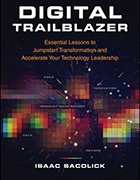4 types of employee reactions to a digital transformation
The success of a digital transformation project depends on employee buy-in. Discover how organizations can address employee reactions to digital transformation.
Although digital transformation can help companies gain a competitive advantage, CIOs must pay attention to the human aspect of the project -- or risk failure.
Employees play a key role in an organization's digital transformation. But they may find the required changes intimidating or overwhelming. Digital transformations push people out of their comfort zone. For example, employees may need to work twice as hard to succeed, especially if they must reskill or upskill. That's why IT leaders must recognize the various employee reactions to a digital transformation initiative.
Employees have many ways of responding to the changes digital transformation requires of them, but typically, four broad camps emerge, according to Isaac Sacolick in his book Digital Trailblazer: Essential Lessons to Jumpstart Transformation and Accelerate Your Technology Leadership. These include the following:
- early adopters who believe in transformational change;
- opportunists who don't get involved until leadership explains what's in it for them;
- employees who resist the disruptions and look for jobs elsewhere; and
- detractors who prefer the status quo.
Since employee commitment is crucial to the success of a digital transformation, IT leaders need to create a culture that supports digital transformation. Engaging with different groups, understanding their perspectives and getting high-quality feedback on any proposed changes is essential to supporting a good employee experience that in turn supports project success.
For example, early adopters may pursue the latest tools and stray from a company's strategic approach to a digital transformation project, Sacolick writes. Aggressive early adopters may negatively affect the project by influencing their fellow employees and taking the focus away from customer priorities.
Emerging leaders passionate about early adoption are better prepared to challenge the status quo and can be beneficial to a successful implementation, Sacolick writes. But IT leaders must find a way to nurture the early adopters into productive roles. Identifying early adopters and strengthening their collaboration skills are crucial to a digital transformation's success.
In this excerpt from Chapter 10 of Digital Trailblazer, Sacolick outlines the four main ways people react to digital transformation initiatives and offers ways to successfully get their buy-in.
Leading digital transformations is fundamentally hard and grinding work, especially when there isn't a direct threat of disruption driving them. They require asking employees to do twice the work.
Not only are you asking your colleagues to complete today's jobs to preserve the primary aspects of the existing business model, you're also asking them to go above and beyond their daily work to transform the business with new business models, target markets, customer segments, digital products, digitally enabled business processes, competitive technologies, and data-driven organizational practices.
Employees immediately recognize the organization's ask of them to perform double-duty work, and their response usually falls into one of four camps. Some embrace the drive to transform and seek leadership roles even in areas they may not have experience. A second group will go along for the ride and will only stretch themselves when leadership clarifies what's in it for them. A third group will ride with the program, but they loathe the added pressure to execute and sometimes quietly look for new jobs.
The fourth group is the detractors who prefer the status quo and doubt the new vision. Some detractors will vocalize their challenges and resentments and find creative ways to commandeer meetings to spread competing gospels or seed doubts. Others will speak out quietly, often to people they trust and select their objections where they have the expertise or a staked interest. Some detractors hold high ranks in the organization and can directly influence their direct reports and organizations. Others may be high potentials or strong influencers and disrupt the transformation's goals and message.
You might think detractors are the biggest issue in leading transformation because they can disrupt, derail, and slow down programs. But constructive detractors can actually be good for transformations, particularly when they voice concerns or ask challenging questions at opportune moments. Leaders should address these questions because they can expose institutional and dated practices, challenge the status quo, and help others evaluate "how we do things today" from new vantage points. Asking questions is exactly what successful transformations require to get people to ask why, promote blue-sky thinking, and identify new opportunities.
Getting a detractor to become constructive is time-consuming, but it's part of the Digital Trailblazer's responsibilities. So, at the outset, show patience and empathy with detractors. Demonstrate that you're a good listener and a strong collaborator, especially when a detractor shares a valid concern, objection, or fresh idea. But if the same people raise the same concerns repetitively and without listening and considering leadership's responses, then their behaviors can be destructive. These situations require one-on-one conversations, and if they persist, their direct managers should be involved. If the detractor is an executive or senior leader in the organization, the CEO should address the behaviors. At some point, destructive detractors who fail to listen and persistently disrupt can be considered performance issues and may require human resources' involvement.
But all four groups pose different challenges.
An aggressive early adopter who pursues the latest and greatest technology solutions may drag teams off the strategic course and customer priorities. You want and need these early adopters and emerging leaders ready to challenge the status quo. A goal for transformation leaders is to find the early adopters, mentor them on collaboration skills, and provide them with the teams, processes, and tools to succeed.
That takes a bit of art and science. Where do you provide these innovation leaders with the leeway, self-organizing practices, decision-making authority, and room to fail so that they own and figure out an optimal success path? How do you manage regulatory restrictions, skill sourcing constraints, budgetary limitations, and security factors so that teams understand and work toward them? And where do you require operational standards, technical best practices, alignment on technology platforms, or rigorous KPIs that constrain some of their authorities?
There are no right or wrong answers to these questions, except we can safely say that an optimal operating model lies between the two extremes of chaotic self-organization and command-and-control process management. It's an equation that must factor in the opportunity, risks, talents, competitive factors, sunk investments, and impacts of failure. In fact, the biggest problem is that many organizations and their leaders are vague in defining decision authorities and standards, leaving it to the individual leader to figure out.
Excerpted with the permission of the publisher, Wiley, from Digital Trailblazer: Essential Lessons to Jumpstart Transformation and Accelerate Your Technology Leadership by Isaac Sacolick. Copyright 2022 by John Wiley & Sons Ltd. All rights reserved. This book is available wherever books and eBooks are sold.








